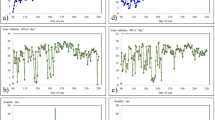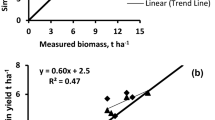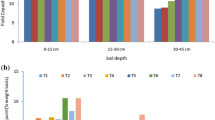Abstract
The objectives of this study were to evaluate the performance of the cropping system model (CSM)-CERES-Rice to simulate growth and development of an aromatic rice variety under irrigated conditions in a semiarid environment of Pakistan and to determine the impact of various plant densities and nitrogen (N) application rates on grain yield and economic return. The crop simulation model was evaluated with experimental data collected in experiments that were conducted in 2000 and 2001 in Faisalabad, Punjab, Pakistan. The experimental design was a randomized complete block design with three replications and included three plant densities (one seedling hill−1, PD1; two seedlings hill−1, PD2; and three seedlings hill−1, PD3) and five N fertilizer regimes (control, N0; 50 kg ha−1, N50; 100 kg ha−1, N100; 150 kg ha−1, N150; and 200 kg ha−1, N200). To determine the most appropriate combination of plant density and N levels, four plant densities from one seedling hill−1 to four seedlings hill−1 and 13 N levels ranging from 0 to 300 kg N ha−1 (52 scenarios) were simulated for 35 years of historical daily weather data under irrigated conditions. The evaluation of CSM-CERES-Rice showed that the model was able to simulate growth and yield of irrigated rice in the semiarid conditions, with an average error of 11% between simulated and observed grain yield. The results of the stimulation analysis result showed that two seedlings hill−1 along with 200 kg N ha−1 (PD2N200) produced the highest yield as compared to all other scenarios. Furthermore, the economic analysis through the mean gini dominance also showed the dominance of this treatment (PD2N200) compared to the other treatment combinations. Thus, the management scenario that consisted of two seedlings hill−1 and 200 kg N ha−1 was the best for high yield and monitory return of irrigated rice in the semiarid environment. The mean monetary returns ranged from 291 US $ ha−1 to 1 460 US $ ha−1 among the 52 production options that were simulated. This approaching was demonstrated as effective way to optimize the density and N management for high yield and monetary return. It will help the rice production.







Similar content being viewed by others
Abbreviations
- CSM:
-
Cropping system model
- GDP:
-
Gross domestic product
- RMSE:
-
Root mean square error
- LAI:
-
Leaf area index
References
Ahmad, S., Ahmad, A., Zia-ul-Haq, M., Ali, H., Khaliq, T., Anjum, M. A., et al. (2009). Resources use efficiency of field grown transplanted rice (Oryza sativa L.) under irrigated semiarid environment. Journal of Food, Agriculture and Environment, 7, 487–492.
Ahmad, S., Zia-ul-Haq, M., Ali, H., Shad, S. A., Ahmad, A., Maqsood, M., et al. (2008). Water and radiation use efficiencies of transplanted rice (Oryza sativa L.) at different plant density and irrigation regimes under semi-arid environment. Pakistan Journal of Botany, 40, 199–209.
Bannayan, M., Crout, N. M. J., & Hoogenboom, G. (2003). Application of the CERES-wheat model for within season prediction of winter wheat yield in the United Kingdom. Agronomy Journal, 95, 114–125.
Banterng, P., Hoogenboom, G., Patannothai, A., Singh, P., Wani, S. P., Pathak, P., et al. (2010). Application of the cropping system model (CSM)-CROPGRO-Soybean for determining optimum management strategies for soybean in tropical environments. Journal of Agronomy and Crop Science, 196, 231–242.
Buccola, S. T., & Subaei, A. (1984). Mean-Gini analysis, stochastic efficiency and weak risk aversion. Australian Journal of Agricultural Economics, 28, 77–86.
Buresh, R. J., Singh, U., Godwin, D. C., Ritchie, J. T., & de Datta, S. K. (1991). Simulation soil nitrogen transformations with CERES-Rice. Agrotechnology Transfer, 13, 7–10.
Cheyglinted, S., Ranamukhaarachchi, S. L., & Singh, G. (2001). Assessment of the CERES-RICE model for production in the central plain of Thailand. Journal of Agricultural Sciences, 137, 289–298.
FAO. (2009). FAOSTAT, Agriculture and food trade. http://www.faostat.fao.org. Accessed 5 November 2009.
FAO. (2011). FAOSTAT Agricultural price statistics. http://faostat.fao.org/site/351/default.aspx. Accessed 28 May 2011.
Fawcett, R. H., & Thornton, P. K. (1989). Mean-Gini dominance in decision analysis. IMA Journal of Mathematics Applied in Business and Industry, 2, 309–317.
Godwin, D. C., & Singh, U. (1998). Nitrogen balance and crop response to nitrogen in upland and lowland cropping systems. In G. Y. Tsuji, G. Hoogenboom, & P. K. Thornton (Eds.), Understanding options for agricultural production (pp. 55–78). Dordrecht: Kluwer Academic Publishers.
GOP. (2007). Economic survey of Pakistan 2006–2007, finance division. Islamabad: Economic Advisory Wing, Finance Division, Govt. of Pakistan.
GOP. (2009). Economic Survey of Pakistan 2008–2009, finance division. Islamabad: Economic Advisory Wing, Finance Division, Govt. of Pakistan.
Hoogenboom, G. (2000). Contribution of agrometeorology to the simulation of crop production and its applications. Agriculture and Forest Meteorology, 103, 137–157.
Hoogenboom, G., Jones, J. W., Wilkens, P. W., Porter, C. H., Batchelor, W. D., Hunt, L. A., et al. (2004). Decision support system for agrotechnology transfer (DSSAT) version 4.0. Honolulu: University of Hawaii, CD-ROM.
Hoogenboom, G., Jones, J. W., Wilkens, P. W., Porter, C. H., Batchelor, W. D., Hunt, L. A., et al. (2010). Decision support system for agrotechnology transfer, (DSSAT) version 4.5. Honolulu: University of Hawaii, CD-ROM.
Hunt, L. A., & Boote, K. J. (1998). Data for model operation, calibration, and evaluation. In G. Y. Tsuji, G. Hoogenboom, & P. K. Thornton (Eds.), Understanding options for agricultural production (pp. 9–39). Dordrecht: Kluwer Academic.
Hunt, L. A., Pararajasingham, S., Jones, J. W., Hoogenboom, G., Imamura, D. T., & Ogoshi, R. M. (1993). GENCALC: Software to facilitate the use of crop models for analyzing field experiments. Agronomy Journal, 85, 1090–1094.
IRRI. (2009). Atlas of rice & world rice statistics. In: IRRI (Ed.), Atlas of rice & world rice statistics. Metro Manila: International Rice Research Institute (IRRI). http://www.irri.org/science/ricestat/index.asp. Accessed 29 October 2009.
Jing, Q., Keulen, H. V., Hengsdijk, H., Cao, A., Bindraban, P. S., Dai, T., et al. (2009). Quantifying N response and N use efficiency in rice-wheat (RW) cropping system under different water management. Journal of Agricultural Sciences, 147, 303–312.
Jintrawet, A. (1995). A decision support system for rapid assessment of lowland rice-based cropping alternatives in Thailand. Agricultural System, 47, 245–258.
Jones, J. W., Hoogenboom, G., Porter, C. H., Boote, K. J., Batchelor, W. D., Hunt, L. A., et al. (2003). The DSSAT cropping system model. European Journal of Agronomy, 18, 235–265.
Kropff, M. J., Bouma, J., & Jones, J. W. (2001). Systems approaches for the design of sustainable agro-ecosystems. Agricultural System, 70, 369–393.
Kropff, M. J., Cassman, K. G., van Laar, H. H., & Peng, S. (1993). Nitrogen and yield potential of irrigated rice. Plant and Soil, 155–156, 391–394.
Kropff, M.J., van Laar, H.H., & Matthews, R. (1994). ORYZA1: An ecophysiological model for irrigation rice production. In: SARP research proceedings (p. 110). Wageningen: DLO Research Institute for Agrobiology and Soil Fertility.
Kumar, R., & Sharma, H. L. (2004). Simulation and validation of CERES-Rice (DSSAT) model in north-western Himalayas. Indian Journal of Agricultural Sciences, 74, 133–137.
Loague, K., & Green, R. E. (1991). Statistical and graphical methods for evaluating solute transport models: Overview and application. Journal of Contaminant Hydrology, 7, 51–73.
Ma, W., Li, J., Ma, L., Wang, F., Sisak, I., Cushman, G., et al. (2009). Nitrogen flow and use efficiency in production and utilization of wheat, rice and maize in China. Agricultural System, 99, 53–63.
Maraseni, T. N., Mushtaq, S., & Maroulis, J. (2009). Greenhouse gas emission from rice inputs: A cross-country assessment. Journal of Agricultural Sciences, 147, 117–126.
Niaz, A., Ibrahim, M., & Ishaq, M. (2003). Assessment of nitrate leaching in wheat-maize cropping system: A lysimeter study. Pakistan Journal of Water Resources, 7, 1–6.
Ritchie, J. T., Singh, U., Godwin, D. C., & Bowen, W. T. (1998). Cereal growth, development and yield. In G. Y. Tsuji, G. Hoogenboom, & P. K. Thornton (Eds.), Understanding options for agricultural production (pp. 79–98). Dordrecht: Kluwer Academic.
Sarkar, R., & Kar, S. (2006). Evaluation of management strategies for sustainable rice-wheat cropping system, using DSSAT seasonal analysis. Journal of Agricultural Sciences, 144, 421–434.
Singh, U. (1994). Nitrogen management strategies for lowland rice cropping systems. In: Proceedings of the international conference on fertilizer usage in the tropics (FERTROP) (pp. 293–306). Kuala Lumpur: Malaysian Society of Soil Science.
Singh, Y., Gupta, R. K., Thind, H. S., Singh, B., Singh, V., Singh, G., et al. (2009). Poultry litter as a nitrogen and phosphorous source for the rice-wheat cropping system. Biology and Fertility of Soils, 45, 701–710.
Singh, U., Patil, S. K., Das, R. O., Padilla, J. L., Singh, V. P., & Pal, A. R. (1999a). Nitrogen dynamics and crop growth on an alfisol and a vertisol under rainfed lowland rice-based cropping system. Field Crops Research, 61, 237–252.
Singh, Y., & Singh, B. (2001). Efficient management of primary nutrients in the rice-wheat system. Journal of Crop Production, 4, 23–86.
Singh, Y., Singh, B., Ladha, J. K., Khind, C. S., Gupta, R. K., Meelu, O. P., et al. (2004). Long-term effects of organic inputs on yield and soil fertility in the rice-wheat rotation. Soil Science Society of America Journal, 68, 845–853.
Singh, U., Wilkens, P.W., Chude, V., & Oikeh, S. (1999a). Predicting the effect of nitrogen deficiency on crop growth duration and yield. In: Proceedings of the fourth international conference on precision agriculture (pp. 1379–1393). Madison: ASA-CSSA-SSSA.
Soler, C. M. T., Hoogenboom, G., Sentelhas, P. C., & Duarte, A. P. (2007a). Growth analysis of maize grown off-season in a subtropical environment under rainfed and irrigated conditions. Journal of Agronomy and Crop Science, 193, 247–261.
Soler, C. M. T., Sentelhas, P. C., & Hoogenboom, G. (2007b). Application of the CSM-CERES-Maize model for planting date evaluation and yield forecasting for maize grown off-season in a subtropical environment. European Journal of Agronomy, 27, 165–177.
St’astna, M., Trnka, M., Kren, J., Dubrovsky, M., & Zalud, Z. (2002). Evaluation of the CERES models in different production regions of the Czech Republic. Rostlina Vyroba, 48, 125–132.
Tahir, M. A., & Rasheed, H. (2008). Distribution of nitrate in the water resources of Pakistan. African Journal of Environmental Science and Technology, 11, 397–403.
Thornton, P. K., & Hoogenboom, G. (1994). A computer program to analyze single-season crop model outputs. Agronomy Journal, 86, 860–868.
Thornton, P. K., Hoogenboom, G., Wilkens, P. W., & Bowen, W. T. (1995). A computer program to analyze multiple-season crop model outputs. Agronomy Journal, 87, 131–136.
Thornton, P. K., Hoogenboom, G., Wilkens, P. W., & Jones, J. W. (1998). Seasonal analysis. In G. Y. Tsuji, G. Uehara, & S. Balas (Eds.), DSSAT version 3, vol. 3–2 (pp. 1–65). Honolulu: University of Hawaii.
Timsina, J., & Connor, D. J. (2001). Productivity and management of rice-wheat cropping systems: Issues and challenges. Field Crops Research, 69, 93–132.
Timsina, J., & Humphreys, E. (2006). Performance of CERES-rice and CERES-wheat models in rice-wheat systems: A review. Agricultural System, 90, 5–31.
Tsuji, G. Y., Hoogenboom, G., & Thornton, P. K. (1998). Understanding options for agricultural production. Systems approaches for sustainable agricultural development. Dordrecht: Kluwer Academic.
USDA (2009). United States Department of Agriculture-National Agricultural Statistics Service, USDA. PSD Online http://www.agcensus.usda.gov. Accessed 12 December 2009.
Wallach, D., & Goffinet, B. (1987). Mean squared error of prediction in models for studying ecological and agronomic systems. Biometrics, 43, 561–573.
Willmott, C. J. (1982). Some comments on the evaluation of model performance. Bulletin of the American Meteorological Society, 63, 1309–1313.
Acknowledgments
The research was supported in part by a Post Doctorate Fellowship Program of the Higher Education Commission (HEC), Islamabad, Pakistan, for the first author of this article. The author particularly is also thankful to the administration of Bahauddin Zakariya University (BZU), Multan, Pakistan for the approval of study leave.
Author information
Authors and Affiliations
Corresponding author
Rights and permissions
About this article
Cite this article
Ahmad, S., Ahmad, A., Soler, C.M.T. et al. Application of the CSM-CERES-Rice model for evaluation of plant density and nitrogen management of fine transplanted rice for an irrigated semiarid environment. Precision Agric 13, 200–218 (2012). https://doi.org/10.1007/s11119-011-9238-1
Published:
Issue Date:
DOI: https://doi.org/10.1007/s11119-011-9238-1




